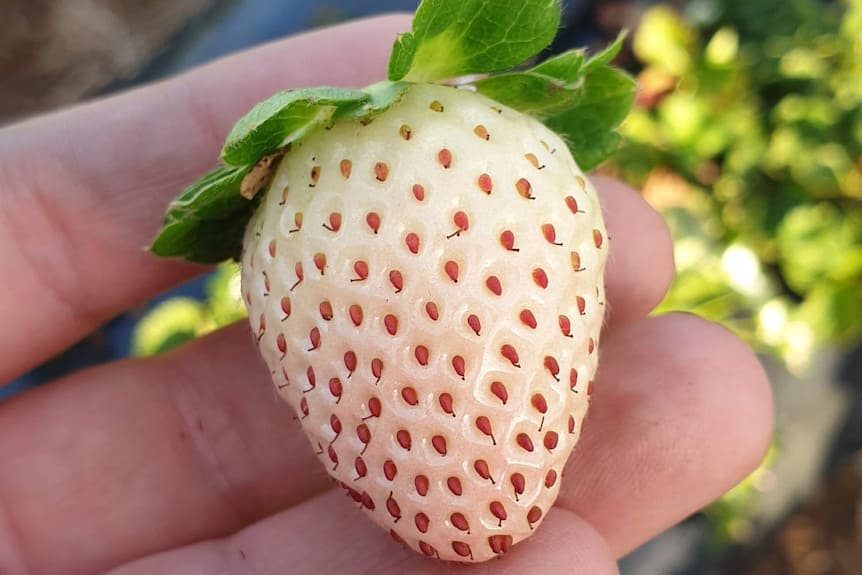Picture this: You’re strolling through the farmers market on a bright Saturday morning when something catches your eye. In a small basket tucked between the usual red strawberries and blueberries, you spot what looks like… albino strawberries?
White berries dotted with tiny red seeds, looking almost too perfect to be real. Your first thought might be, “Are these even ripe?” But prepare to have your mind blown—these pale beauties are not only ripe, they might just be the sweetest discovery you’ll make all year.
Welcome to the fascinating world of white strawberries, where nature’s artistry meets unexpected flavor in the most delightful way possible.
What Exactly Are White Strawberries?
White strawberries aren’t some laboratory creation or unripe fruit masquerading as something exotic. They’re the real deal—authentic strawberries that happen to sport a creamy white exterior instead of the classic red we’re accustomed to. Think of them as strawberries’ mysterious cousin who chose a different path in life.
The most famous variety you’ll encounter is the pineberry, a name that perfectly captures their essence by combining “pineapple” and “strawberry.” These commercial darlings were developed through careful cross-breeding between South American beach strawberries (Fragaria chiloensis) and North American wild strawberries (Fragaria virginiana).

But the white strawberry family includes several distinct personalities.
White Alpine strawberries (Fragaria vesca) are the woodland wanderers—smaller, more delicate fruits that have been growing wild in Europe for centuries. Varieties like ‘White Delight’ and ‘Pineapple Crush’ offer intense flavors packed into tiny packages.
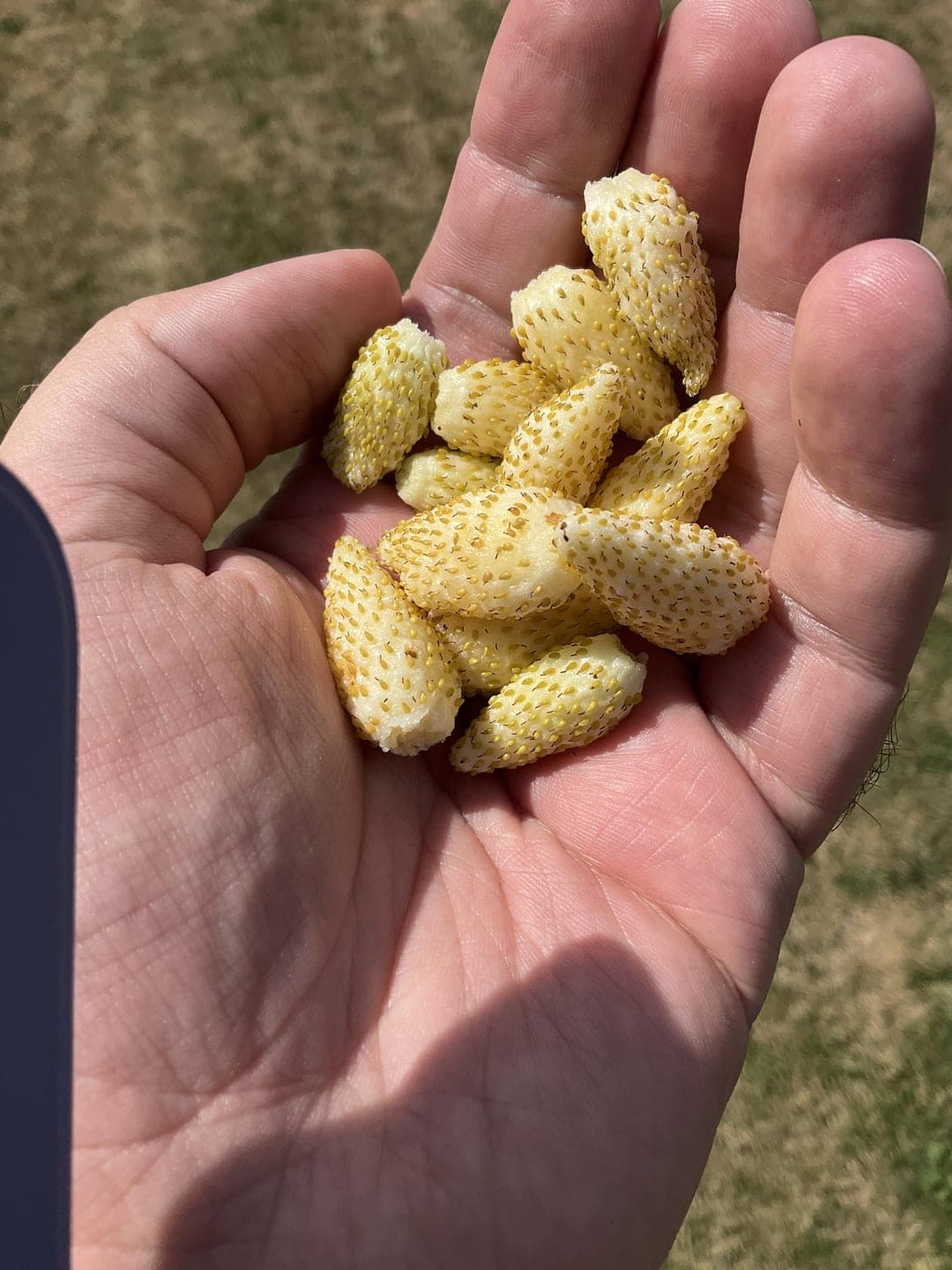
White Beach strawberries are the original white strawberries from Chile, where they’ve been growing wild along the coast for over a thousand years. These tough little survivors are the ancestors of many modern varieties.
The Remarkable Journey From Chile to Your Garden
The story of white strawberries reads like a botanical adventure novel. Long before European colonists ever set foot in the Americas, indigenous peoples in Chile were cultivating these pale gems in the mountainous Mananal region, where they associated the winter harvest with Christmas and New Year celebrations.
Spanish explorers discovered them in the early 1600s and were immediately captivated by their unusual appearance and exceptional taste.
Imagine being one of those early explorers, accustomed to tiny, tart wild strawberries back home, suddenly encountering these large, sweet, pale fruits. It must have felt like discovering treasure.
The real magic happened in 1712 when French engineer François Frézier brought five precious plants back to Europe after a grueling six-month sea voyage. These hardy survivors became the foundation for all modern strawberries when they were successfully crossed with North American varieties in Brest, France, in 1766.
It’s remarkable to think that every strawberry you’ve ever eaten can trace its lineage back to those five plants that somehow survived that perilous ocean crossing.
But white strawberries remained largely forgotten until Dutch farmers rediscovered them in France in the early 2000s. After six years of patient cultivation and selection, they reintroduced pineberries to the world in 2010, creating an instant sensation that had food enthusiasts scrambling to get their hands on these “new” fruits.
The Science Behind the White: Why Aren’t They Red?
Here’s where things get scientifically fascinating. All strawberries start their journey the same way—as small white flowers that develop into green, then white berries. In regular strawberries, as the fruit matures, a protein called Fra a1 (Fragaria allergen 1) kicks into action, transforming the white flesh into that familiar ruby red.
White strawberries are essentially missing this genetic switch. They lack sufficient levels of Fra a1, so they remain beautifully pale throughout their ripening process. It’s like they decided to freeze-frame themselves at the white stage and call it perfect.
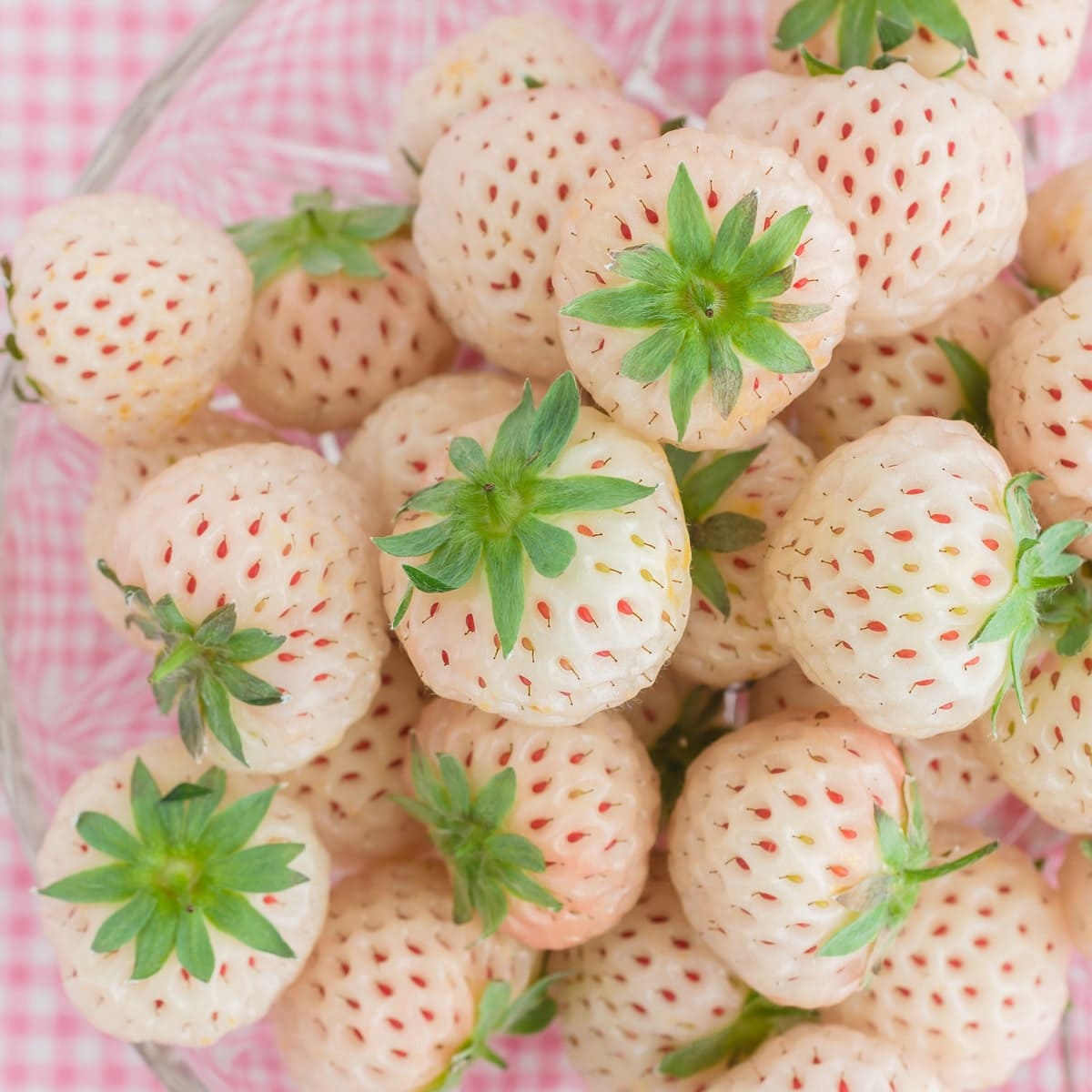
This genetic quirk has an unexpected bonus: because Fra a1 is also the primary culprit behind strawberry allergies, many people who can’t enjoy regular strawberries can safely indulge in white varieties.
However, if you have a known strawberry allergy, consult with your doctor before experimenting—some white varieties like pineberries that develop a pink blush may still contain trace amounts of the protein.
Taste Test: What Do White Strawberries Actually Taste Like?
This is where white strawberries truly shine. Despite their pale appearance, they pack a flavor punch that’s often more complex and interesting than their red counterparts.
Pineberries live up to their name with a delightful tropical twist. Imagine biting into a strawberry and getting hit with sweet strawberry flavor followed by subtle notes of pineapple, sometimes with hints of citrus, caramel, or even grape.
The texture remains true to strawberry form—soft, juicy, and satisfying, though often with a more delicate, almost silky mouthfeel.

Many people describe white strawberries as sweeter than regular varieties, with a more perfumed quality. The flavor can vary significantly based on growing conditions, variety, and ripeness. Alpine varieties tend to be intensely aromatic with complex flavor profiles, while pineberries offer that signature tropical note that makes them so distinctive.
I remember the first time I tried a pineberry—I was expecting it to taste like an unripe strawberry, maybe a bit sour or bland. Instead, I got this incredible burst of sweetness with this mysterious tropical flavor I couldn’t quite place. It was like my taste buds were playing a fun guessing game.
For the best flavor experience, let white strawberries sit at room temperature for about thirty minutes before eating. This simple step allows their complex aromatics to fully develop and intensifies their natural sweetness.
Nutritional Powerhouse in Pale Packaging
Don’t let their delicate appearance fool you—white strawberries pack the same nutritional punch as their red cousins. They’re loaded with vitamin C, often containing more than oranges, along with significant amounts of vitamin A, potassium, and antioxidants that support immune function and skin health.
The high water content (about 90%) makes them excellent for hydration, while their fiber content supports digestive health. They’re also rich in ellagic acid, which helps protect hair from damage and gives skin a healthy glow. The antioxidant profile may even help reduce stress levels, making these pale beauties a natural mood booster.
Growing Your Own White Strawberry Paradise
The good news? If you can grow regular strawberries, you can absolutely grow white ones. The care requirements are nearly identical, with just a few key differences that can make the difference between a disappointing harvest and strawberry success.
Choosing Your Location and Preparing the Stage
Choose a sunny spot that gets at least six hours of direct sunlight daily, preferably morning sun with some afternoon protection in very hot climates.
White strawberries are perennial plants that will call this home for several years, so invest time in choosing the perfect location. They thrive in slightly acidic soil with a pH between 5.5 and 6.5—think of it as creating a mountain meadow environment similar to their Chilean origins.

Prepare your soil by working in plenty of compost or aged manure several weeks before planting. These plants have shallow root systems and appreciate rich, well-draining soil that holds moisture without becoming waterlogged.
Avoid areas where tomatoes, peppers, or eggplants have grown in the past four years, as these can leave behind pathogens like Verticillium wilt that seriously harm strawberry plants.
The Critical Pollination Partnership
Here’s the crucial difference that many new growers miss: white strawberries need red strawberry friends for optimal fruit production. While they can self-pollinate to some degree, they produce dramatically better yields when cross-pollinated with regular strawberry varieties. Aim for a ratio of about four white strawberry plants to every one red variety.
This isn’t just about the white strawberries—the red ones benefit too, often producing larger, more abundant fruit when grown alongside their pale cousins. Think of it as creating a diverse strawberry community where everyone helps everyone else succeed.
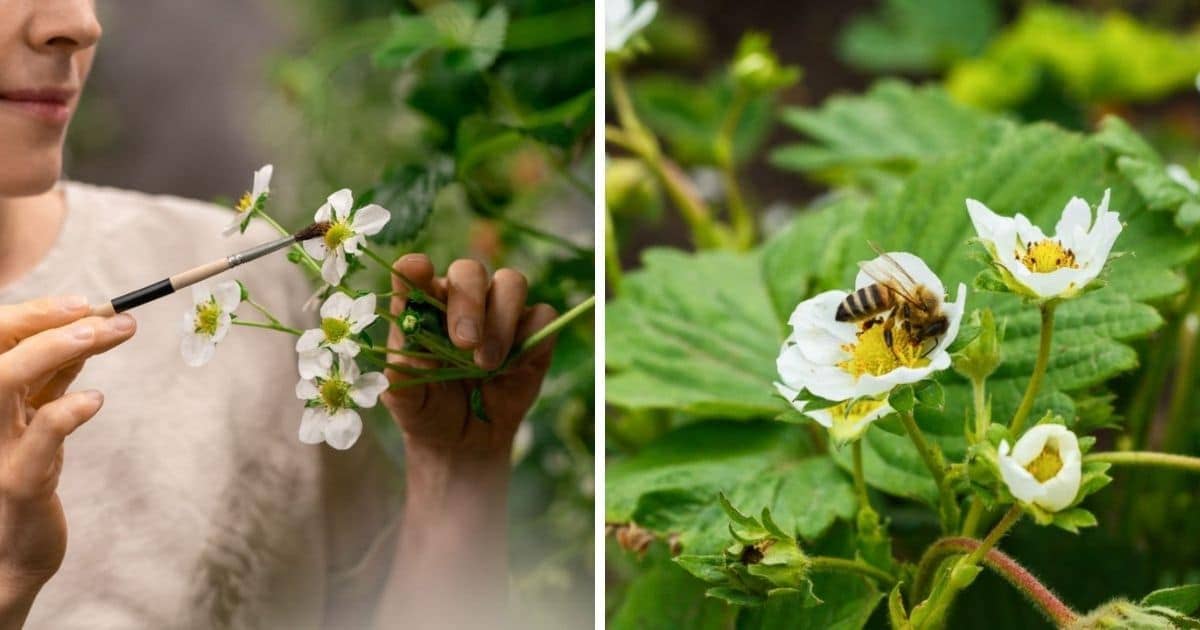
Popular pollinator varieties include ‘Sonata’ and ‘Cavendish’, which bloom at the same time as most white varieties.
Planting for Success
Plant your strawberries in early spring after the soil has warmed and the danger of hard frost has passed, typically when soil temperature reaches 60°F. In milder climates, fall planting can work well, giving roots time to establish for a strong spring showing.
Space plants 12-18 inches apart in rows, with the crown (where the leaves meet the roots) sitting exactly at soil level. This is absolutely critical—burying the crown leads to rot, while exposing it causes the plant to dry out. Create a small mound in your planting hole so you can spread the roots down the sides while keeping the crown perfectly positioned.

Water immediately after planting and apply a layer of straw mulch around (but not touching) the plants. This mulch is your secret weapon for clean berries, moisture retention, and weed suppression.
Managing Water and Nutrients
Consistent moisture is key, but white strawberries are particularly sensitive to waterlogged conditions. The soil should feel like a wrung-out sponge—moist but not soggy. Drip irrigation or soaker hoses work beautifully by delivering water directly to the root zone while keeping foliage dry.
During the growing season, feed your plants every 2-4 weeks with a fertilizer high in phosphorus and potassium but moderate in nitrogen. Too much nitrogen creates lush foliage at the expense of fruit production. As temperatures cool in fall, reduce fertilizing to help plants prepare for winter dormancy.
👉 Read the Best Blueberry Fertilizer Guide: Avoid Mistakes, Maximize Harvests
Understanding the Timeline and Setting Expectations
Here’s where patience becomes a virtue: most white strawberry varieties won’t produce fruit in their first year. They’re busy establishing their root systems and building strength for future harvests. This initial investment pays off handsomely in year two and beyond.
Once established, many white varieties are everbearing, providing multiple flushes of fruit throughout the growing season rather than one large June crop. In optimal conditions, expect to harvest berries from late spring through early fall, with peak production typically occurring in early summer.
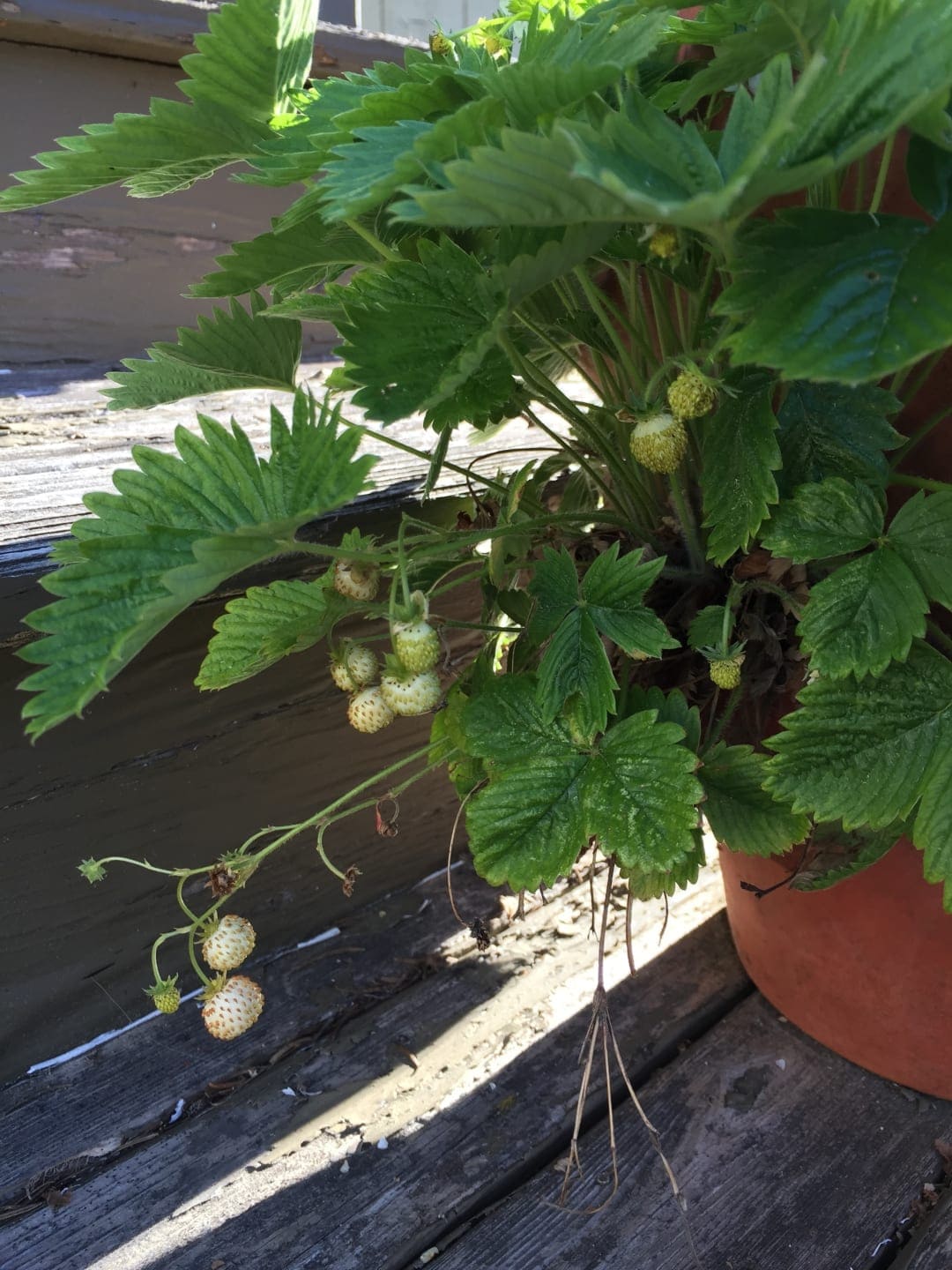
The berries themselves will be smaller than most commercial red strawberries—think dime to quarter-sized rather than golf ball-sized. But what they lack in size, they make up for in flavor intensity and uniqueness. A mature plant might produce 20-30 berries per season, though this varies significantly by variety and growing conditions.
Recognizing Harvest Time and Maximizing Flavor
Knowing when white strawberries are ripe takes practice since the usual “red means ready” rule doesn’t apply. Look for berries that have transitioned from a greenish-white to a creamy, almost ivory white.
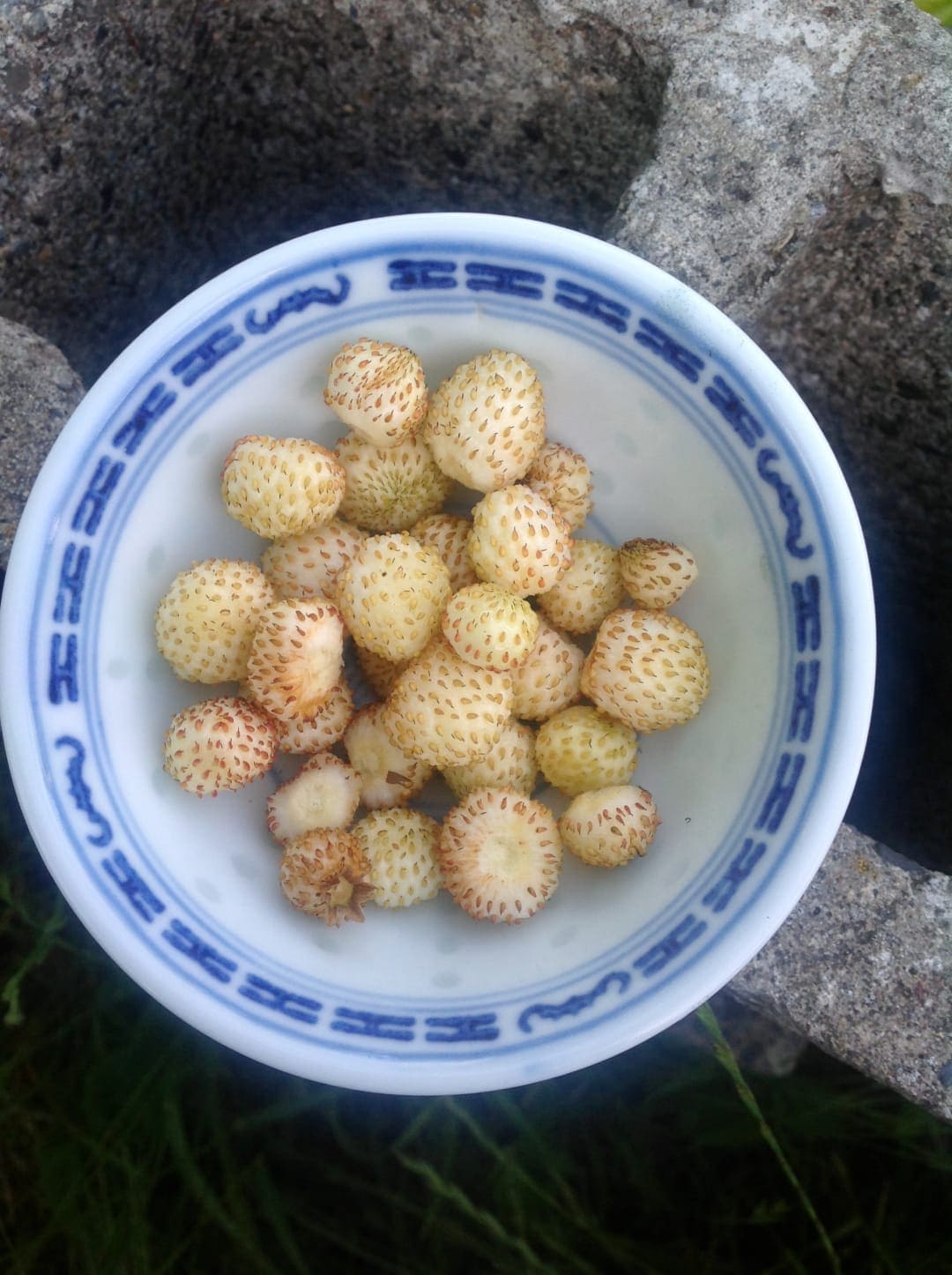
The seeds should be bright red and slightly raised from the surface. Some varieties develop a subtle pink blush when fully ripe, especially when grown in full sun.
The berries should yield slightly to gentle pressure and release that characteristic sweet, pineapple-like aroma. Harvest in the morning after dew has dried but before the heat of the day for the best flavor concentration.
👉 Discover When and How to Harvest Vegetables for Peak Flavor: Timing and Tips for Every Crop
Troubleshooting Common Challenges
White strawberries can be particular about their growing conditions, and understanding their quirks helps ensure success. If flowers appear but no fruit develops, the likely culprit is inadequate pollination—make sure you have red strawberry companions and that beneficial insects can access the flowers.
Crown rot, indicated by wilting plants with brown, mushy crowns, usually results from planting too deeply or poor drainage. Leaf scorch and yellowing often signal watering issues—either too much or too little. Spider mites and aphids can be problematic in hot, dry conditions, while slugs love the soft berries just as much as you do.
For container growing, choose pots at least 12 inches wide and 8 inches deep with excellent drainage. Container plants need more frequent watering and feeding but give you complete control over soil conditions. In harsh winter climates, container plants may need protection in an unheated garage or cold frame.
👉 Here’s How to Grow Potatoes in Containers: Tips for a Bountiful Harvest
Runner Management and Propagation
One of the joys of growing white strawberries is their ability to propagate through runners—long stems that develop new plants at their tips. These runners are your ticket to expanding your white strawberry collection without additional plant purchases.
Allow runners to develop and root naturally, then either leave them attached to create a living mulch or transplant them to new locations. If space is limited, remove runners promptly to keep plants focused on fruit production rather than expansion.
👉 Here’s How to Propagate Plants in Water: Easy Step-by-Step Method
Seasonal Availability and Where to Find Them
Understanding when and where to find white strawberries helps you plan your purchases and growing schedule. Commercial production occurs primarily in Florida (November through April) and California (January through October), with peak availability in late winter and early spring when they command premium prices.
Fresh white strawberries are becoming more available in specialty stores, farmers markets, and even some mainstream supermarkets during peak season. Expect to pay $6-10 for a small container due to their limited production and delicate nature.
In Japan, premium varieties like ‘White Jewel’ can command $10 per individual berry, treated as luxury gifts similar to perfect melons.
For plants, reputable nurseries offer varieties like ‘White Pine’ (the classic pineberry), ‘White Carolina’ (develops lovely pink blush), ‘Natural Albino’ (requires cross-pollination but offers exceptional flavor), and various alpine varieties. Order plants in late winter for spring delivery, as popular varieties often sell out quickly.
Culinary Adventures: Showcasing White Strawberries
White strawberries shine in applications where you want strawberry flavor without color interference, and their unique appearance creates stunning visual impact. They’re spectacular in elegant desserts like vanilla panna cotta or white chocolate tarts, where their pale beauty provides sophisticated contrast.
For dramatic presentations, combine white and red strawberries in fruit salads, on cheese boards, or in layered desserts. Their tropical notes pair beautifully with coconut, vanilla, citrus, and other berries. They make exceptional cocktail garnishes—imagine a white strawberry floating in champagne or adorning the rim of a tropical drink.
In preserves, white strawberry jam has an almost ethereal appearance while delivering complex flavor that’s perfect for elegant breakfast presentations or gourmet gift baskets. For baking, they work wonderfully in applications where you want strawberry flavor without the color bleeding that red berries can cause.

The key to maximizing their culinary potential is understanding their delicate nature. They bruise easily and have shorter shelf lives than red strawberries, typically lasting 2-3 days refrigerated. Handle them gently, wash only just before use, and remember that room temperature serving brings out their best flavors.
Common Questions and Practical Answers
- Q: Are white strawberries genetically modified?
A: Absolutely not. White strawberries are the result of traditional cross-breeding techniques, not genetic engineering. They’re actually closer to the original wild strawberries than many red commercial varieties.
- Q: Can I grow white strawberries from seeds?
A: Unfortunately, no. White strawberries are hybrids, so seeds from the fruit won’t produce plants with the same characteristics. You need to start with plants or runners from existing plants.
- Q: Do birds bother white strawberries as much as red ones?
A: This is one of their surprising advantages! Birds seem less attracted to white strawberries, possibly because the pale color doesn’t trigger their “ripe fruit” recognition. You may still want to use netting during peak season, but bird damage is typically much less severe.
- Q: How long do white strawberries keep after picking?
A: They’re more perishable than red strawberries, typically lasting 2-3 days in the refrigerator. For best flavor, let them come to room temperature before eating, as this brings out their complex taste profile.
- Q: Can I freeze white strawberries?
A: Yes! Wash, hull, and slice them, then freeze on a lined baking sheet before transferring to freezer bags. They’re perfect for smoothies or baking applications after freezing.
- Q: What’s the best variety for beginners?
A: Start with ‘White Pine’ pineberries—they’re relatively easy to grow, have good flavor, and are widely available. Pair them with ‘Sonata’ red strawberries for optimal pollination.
Your White Strawberry Journey Starts Here
White strawberries represent something special in our increasingly uniform food world—a reminder that nature still holds surprises and that the most extraordinary experiences often come in unexpected packages.
Whether you’re drawn to their unique appearance, intrigued by their complex flavor, or simply love the idea of growing something that makes visitors do a double-take, white strawberries offer rewards far beyond their delicate appearance.
The investment in growing white strawberries pays dividends not just in unique fruit, but in the satisfaction of successfully cultivating something truly special. There’s something magical about serving guests strawberries they’ve never seen before, watching their surprise turn to delight as they discover the complex flavors hidden in those pale berries.
Start small with a few plants tucked into your existing strawberry patch or a large container garden. Choose a sunny spot, prepare rich soil, and remember to plant some red strawberry companions.
With patience and proper care, you’ll soon be harvesting your own pale treasures and discovering why these mysterious berries have captivated gardeners and food lovers around the world.
The world of white strawberries is waiting to be explored, offering flavors and experiences that remind us why growing our own food remains one of life’s most rewarding adventures.
Why not start your own pale berry adventure today? Your taste buds—and your garden visitors—will thank you for introducing them to these remarkable fruits that prove sometimes the most beautiful things in life come in the most unexpected colors.
